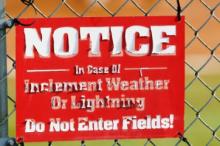
According to a 2013 position statement issued by the National Athletic Trainers' Association, a proper lightning safety policy consists of the following 8-point plan:
1. Establish a lightning-specific emergency action plan. Sports programs should formalize and implement a comprehensive, pro-active emergency action plan (EAP) specific to lightning safety which is rehearsed annually and includes:
- Promoting National Weather Service lightning safety slogans such as "No Place Outside is Safe When Thunderstorms are in the Area" or "Half an Hour Since Thunder Roars, Now it's Safe to Go Outdoors."
- Establishing a chain of command that identifies a specific person to make decisions to remove individuals from the field.
- Using a reliable means of monitoring the local weather (see below)
- Identifying safe locations from lightning hazard in advance of events, such as a building where people live or work or a fully enclosed space (or car). Be aware of unsafe locations such as shelters, picnic tables or bus stops, which are partially open to the elements. Other unsafe venue such as towers or trees can also be targets for lightning. Know how long it will take to get to the safe venues and plan accordingly.
- Identifying specific criteria for suspending and resuming activity, and allow time for evacuation of the premises. Activities should be suspended until 30 minutes after the last lightning strike or sound of thunder.
2. Ensure lightning and general weather awareness: Recognizing and avoiding the lightning hazard is of utmost importance.
- Use a designated weather watcher to be actively looking for signs of approaching or developing local thunderstorms, such as high winds, darkening cloudes, or lightning and thunder.
- Use the National Weather Service to monitor local weather before and during outdoor events (note, however, that the NWS does not regularly issue lightning warnings in all locations, nor does it necessarily broadcast information on specific storms).
- Organizers, particularly of larger events, should watch the skies for approaching or locally developing thunderstorms and obtain continual updates on the local weather from electronic media, including NOAA.
- Consider subscribing to a commercial, real-time lightning detection service that has been independently verified so you can determine how far away a storm is and when it is best to go inside. As of 2012, 3 major providers of thses lightning-detection services are available in the United States: US National Lightning Detection Network (NLDN), operated by Vaisala Inc (Tuscon, AZ); US Precision Lightning Network (USPLN), operated by WSI Corp. (Andover, MA); and WeatherBug Total Lightning Network, operated by WeatherBug (Germantown, MD). The NLDN has been operated continuously since January 1989, and detects cloud-to-ground lightning in real time with a median location error of 250 meters and a flash-detection effeciency of more than 90%.
- Important note: pagers, cell phones, smartphones, or email can transmit notifications, but, while useful, the NATA says they should only supplement the other procedures listed above and, in certain situations, they can actually lull the untrained into a false sense of security. If one does not know how to interpret the data or warnings or is not familiar with the EAP and how to implement it, having a system may be worse than not having a system at all.
3. Identify locations safe from lightning
- For each venue, identify substantial, fully-enclosed buildings with wiring and plumbing, such as a school, field house, library, home, or similar habitable building to serve as a safe place from lightning. Note: fully enclosed metal vehicles such as school buses, cars, and vans are also safe locations for evacuations, but convertibles, nonmetal, or open, such as golf carts and most-off-the-road vehicles, provide no lightning protection.



